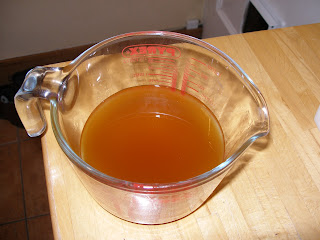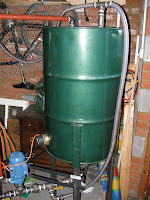Today I made a batch in the processor !
I moved 96 litres of Waste oil into the processor, heated to 55C and added the 21.5 litres of Methanol and NaOH. It then circulated for 2 hours and then settled for another hour. I then drained off from the bottom of the tank about 18 litres of dark red liquid (glycerin) until the liquid became a golden yellow/wheat colour.
Here's a sample:

It looks
pretty cloudy as there's still a few impurities in there. These will drop out (and be filtered out) once the left over methanol is removed. This is done through evaporation (from heating or
naturally to the
surrounding air). I heated this sample on
the hob and took it to about 70c (around 160F) for 5
mins. Once it had cooled a little I decanted it (there was a distinct puddle of dark "stuff" (liquid and a few lumps) in the bottom) and filtered it through a coffee filter (Google suggests a coffee filter is around 20 microns).
In this shot, you can see the line of the darker liquid and the line at the edge of the bio.
The resulting liquid is much clearer!

I also did a quick test known as the 3 in 27 or 3/27 test. You take 27ml of methanol and add 3ml of the biodiesel (ie the sample). once added, you shake/mix for 5 seconds and then look to see if there is any separation. If the process is incomplete, there will be a "bubble" (a bit like in a spirit level) under the methanol. if there is no bubble, it means the reaction is at or around 96% complete (which is good!). This batch had NO bubble!
 It looks pretty cloudy as there's still a few impurities in there. These will drop out (and be filtered out) once the left over methanol is removed. This is done through evaporation (from heating or naturally to the surrounding air). I heated this sample on the hob and took it to about 70c (around 160F) for 5 mins. Once it had cooled a little I decanted it (there was a distinct puddle of dark "stuff" (liquid and a few lumps) in the bottom) and filtered it through a coffee filter (Google suggests a coffee filter is around 20 microns).
It looks pretty cloudy as there's still a few impurities in there. These will drop out (and be filtered out) once the left over methanol is removed. This is done through evaporation (from heating or naturally to the surrounding air). I heated this sample on the hob and took it to about 70c (around 160F) for 5 mins. Once it had cooled a little I decanted it (there was a distinct puddle of dark "stuff" (liquid and a few lumps) in the bottom) and filtered it through a coffee filter (Google suggests a coffee filter is around 20 microns).





 In the foreground yo can see the input filter (Blue and white). This is where the first pump sucks in raw oil. If the oil has been used, it will need filtering, hence the 250 micron filter.
In the foreground yo can see the input filter (Blue and white). This is where the first pump sucks in raw oil. If the oil has been used, it will need filtering, hence the 250 micron filter.





 Lastly, I the welder has attacjed three box sections of steel to the sides of the tanks. Into these go the support legs to raise the tanks off the ground. Once in place the taks stand a little under 6 feet tall.
Lastly, I the welder has attacjed three box sections of steel to the sides of the tanks. Into these go the support legs to raise the tanks off the ground. Once in place the taks stand a little under 6 feet tall. 